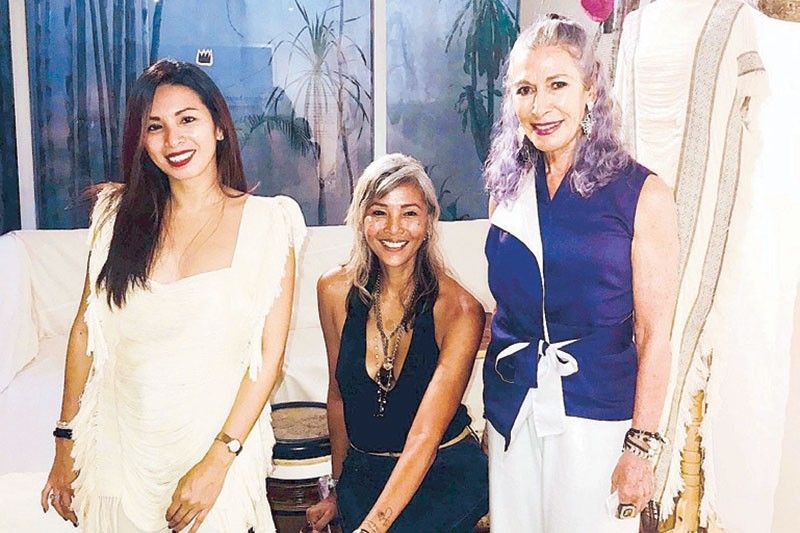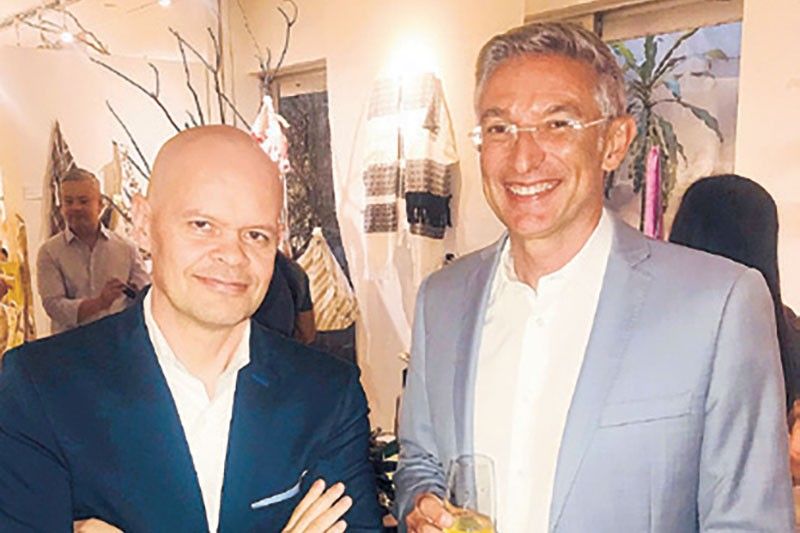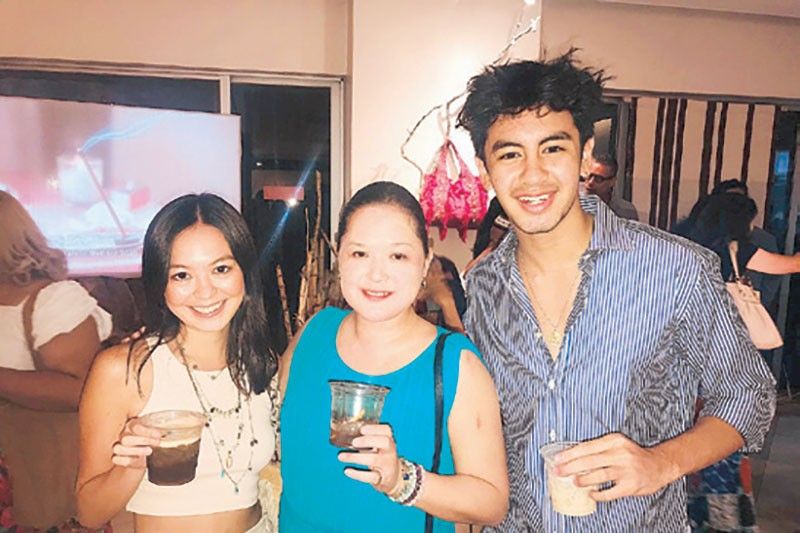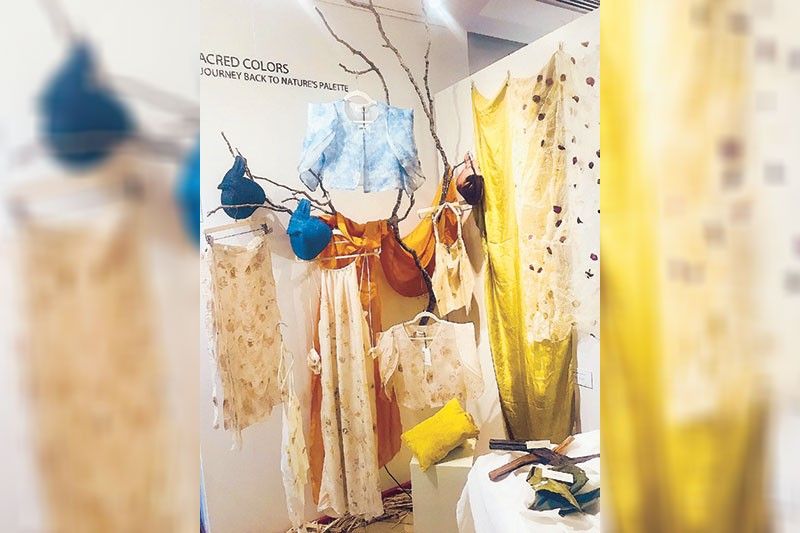
Philippine heritage blooms with the artistry of Bea Roxas, Adrienne Charuel and Clair Barberis at their Alliance Française exhibit where sustainability and creativity go hand in hand.
Each of them specializes in various products made into interesting designs — sugarcane fabric tote bags and home accessories, hand-loomed, cotton-dyed with native flowers and leaves, versatile piña tops that will last a couple of lifetimes, lamps and home accessories — from discarded metal, fallen trees, and sustainable materials crafted by farmers, former cigarette vendors and talented housewives in various low-income communities.

Kanya By Bea Roxas
Bagasse or sugarcane pulp is what remains once the juice is extracted and turned into sugar. This is usually burnt as fuel for the sugar mills, but Bea has ingeniously combined it with cotton and transformed into versatile bags, totes, table linens and fabric for various uses.
The woven accessories and homeware products can be considered modern heirlooms, honoring Filipino roots through quality craftsmanship with an emphasis on social impact. Using artisanal technology, the lowly bagasse has been transformed into a pioneering eco-friendly, natural weaving fabric. The process generates employment and alternative livelihood opportunities to a rural community in Batangas, an agricultural community almost synonymous to sugarcane.
Bea’s biggest hurdle was to make the farmers believe in themselves in 2015. From growing sugarcane, they learned to process its byproducts, spin, weave, and sew the fabrics into delicate, as well as minimalist designs that people would appreciate and buy.
“The sale of our collection provides stable jobs to 40 individuals while stimulating an artisanal industry rooted in sugarcane. Behind each and every one of these pieces is someone’s story which we want to share with you,” Bea enthused. “This beautiful project where the people are the major factor — bags carry their names Dessa, Leeza, Olivia, etc.” The fashionable products are sold in Rustan’s and Rockwell.
When there is a slump in Kanya orders, the workers continue earning by planting and harvesting organic vegetables in Nasugbu, which are sold to resorts, restaurants and homeowners. A pattern of usefulness and profitability continues.

Maison Metisse by Adrienne Chareul
Adrienne takes the challenge of artisan craftsmanship seriously, respecting Philippine heritage infused with sacred traditions.
“Crafting the clothes and home accessories requires the expertise and skill of dedicated artisans who uphold the legacy of our ancestors. I wanted to reintroduce these values and cultivate a deeper appreciation and respect for artisan craftsmanship. Educating and raising awareness are fundamental aspects of my creative vision. By taking visitors on a journey through each step of creating a piece — from the raw materials to the sacred craft and the final design — we aim to offer a profound insight into the world of sacred heritage. Through these initiatives, we aim to revive and honor what has been neglected and undervalued in the realm of craft and design. We don’t just craft fashion; we weave dreams, build communities, and ignite inspiration,” Adrienne shared.
Maison Metisse is proud of the in-house team, as well as the establishment of a weave and dye atelier. The workspace is a platform for transformation as it enriches the workers’ lives, laying the groundwork for a lasting positive impact that resonates through future generations of their families.

Artifeks by Clair Concepcion Barberis
The brand is dedicated to transforming lives with handcrafted objects. The artisans were once marginalized roadside workers (cigarette vendors, kariton pushers, homeless individuals) who then worked as basic welders, painters, fiberglass line workers, factory finishers. Guided by precision and quality at the atelier, they became artisans with a new mind set and mentorship.
Design and technique remains innovative and forward thinking. These were achieved through constant systematic research and experimentation with an emphasis on upcycling and recycling of local raw materials such as plant fibers, handwoven textiles and wood.
Clair explained, “We are a conscientious, artisanal, Filipino design and manufacturing studio with people, planet and prosperity at the heart of everything we do. Our team’s creative and collective energy ensures that our ethos is applied in our culture and workflow from product development, sourcing, upcycling and recycling local raw materials such as plant fibers, handwoven textiles and wood.”
* * *
The exhibit runs until May 18 at the Aliance Française with a schedule of various workshops open to the public. Their brick and mortar store, Domisilyô, will open in Poblacion, Makati area by mid May. Instagram: @domisilyo
*****
Credit belongs to : www.philstar.com
 MaharlikaNews | Canada Leading Online Filipino Newspaper Portal The No. 1 most engaged information website for Filipino – Canadian in Canada. MaharlikaNews.com received almost a quarter a million visitors in 2020.
MaharlikaNews | Canada Leading Online Filipino Newspaper Portal The No. 1 most engaged information website for Filipino – Canadian in Canada. MaharlikaNews.com received almost a quarter a million visitors in 2020.
